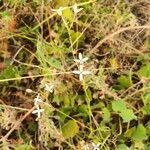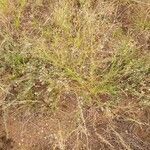Annual, perennial or sometimes subshrubby herb, usually erect, 10–90 cm. tall, branched at the base with several to many caespitose glabrous to densely scabridulous pubescent stems; rootstock containing a red dye.. Leaves linear to linear-lanceolate or narrowly elliptic, 0.5–8 cm. long, 0.3–5(–12) mm. wide, acute to narrowly apiculate at the apex, narrowed to the base, glabrescent to densely scabridulous-pubescent or-papillose; stipular sheath 1–8 mm. long, produced into 2–5 filiform fimbriae 0.5–3 mm. long.. Inflorescences often trichotomous or dichasial, the branches often again similarly branched, the flowers usually solitary at the nodes; peduncles 0–8 cm. long; pedicels almost obsolete or up to 1.1(–2.4) cm. long (though often in these cases the stalk is a reduced branchlet).. Calyx-tube ovoid, ± 1 mm. long, verruculose, scabridulous or glabrous; lobes lanceolate to triangular, 0.5–2 mm. long, glabrous or with indistinctly scabridulous margins, the teeth often with secondary elements between and sometimes developed into quite distinct filaments.. Flowers scented; corolla white, grey, buff, yellowish, pink or lilac, the tube often purplish and the lobes ochraceous, nearly always pale inside, glabrous or papillate outside; tube narrowly cylindrical, (0.8–)1.15–1.4 cm. long, the widened part 1.5–3 mm. long, 0.5(–1.5) mm. wide; lobes linear-oblong to narrowly elliptic, 2–6 mm. long, 0.6–1.2(–1.7) mm. wide.. Style 1.5–4 mm. long, in one variety just touching the anthers.. Capsule subglobose or ovoid, 1.5–4 mm. tall, 2–3(–5.5) mm. wide, verruculose, hispidulous or glabrous, the beak slightly raised at dehiscence.. Seeds pale olive-brown, angular-subconic, ± 0.3 mm. long, reticulate.
More
According to my recent investigations and revision of the genus, this somewhat variable species can be divided into 3 subspecies of which only 1 (subsp. brachyloba) occurs in the Flora Zambesiaca area. Subsp. caespitosa occurs in N.E. Africa (Sudan, N. Ethiopia, N. Somalia, Egypt), Sinai and the Arabian peninsula, whereas subsp. amaniensis is found in S. Somalia, S. Ethiopia, E. Uganda, Kenya and N. Tanzania.
Suberect, annual or perennial herb, up to 0.8 m tall. Leaves sessile, opposite, mostly narrowly linear-lanceolate to lanceolate elliptic, rarely linear. Flowers in terminal paniclelike inflorescences, usually 2 per node, white, cream or yellowish, darker beneath, scented. Capsule subglobose, with coarse rounded or flattened triangular, white papillae or hairs.


